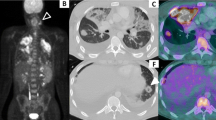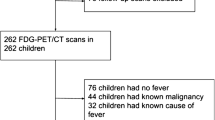Abstract
Background
Our study aims to explore the current utilisation of 18F-fluorodeoxyglucose positron emission tomography/computed tomography (FDG-PET/CT) in the diagnostic pathway of pyrexia of unknown origin (PUO) and associated cost of illness in a large tertiary teaching hospital in Australia.
Method
1257 febrile patients between June 2016 and September 2022 were retrospectively reviewed. There were 57 patients who met the inclusion criteria of “classical PUO”, of which FDG-PET/CT was performed in 31 inpatients, 15 outpatients and 11 inpatients did not have an FDG-PET/CT scan. The patient demographics, clinical characteristics and inpatient cost were analysed, together with the diagnostic performance of FDG-PET/CT and impact on clinical management.
Result
The mean age, length of stay and total cost of admission were higher for inpatients who received FDG-PET/CT versus those who did not. The median cost per patient-bed-day did not differ between the two groups. Inpatients who received earlier FDG-PET/CTs (≤ 7 days from admission) had shorter length of stays and lower total cost compared to those who received a later scan. A negative FDG-PET/CT scan, demonstrating no serious or life-threatening abnormalities resulted in subsequent discharge from hospital or outpatient clinic in 7/10 (70%) patients. There were 11/40 (28%) scans where ancillary abnormalities were identified, requiring further evaluation.
Conclusion
FDG-PET/CT showed high diagnostic accuracy and significant impact on patient management in patients with PUO. FDG-PET/CT performed earlier in admission for PUO was associated with shorter length of stay and lower total cost.


Similar content being viewed by others
Data Availability
The datasets used and/or analysed during the current study are available from the corresponding author on reasonable request.
Abbreviations
- PUO:
-
Pyrexia of unknown origin
- FDG-PET/CT:
-
18F-fluorodeoxyglucose positron emission tomography combined with computed tomography
- COI:
-
Cost of illness
- NIID:
-
Non-infectious inflammatory disease
- CT:
-
Computed tomography
- MRI:
-
Magnetic resonance imaging
- US:
-
Ultrasound
- HITH:
-
Hospital-in-the-home
- TP:
-
True positive
- TN:
-
True negative
- FN:
-
False negative
- FP:
-
False positive
- PPV:
-
Positive predictive value
- NPV:
-
Negative predictive value
- IQR:
-
Interquartile range
- LOS:
-
Length of stay
- $AUD:
-
Australian Dollar
References
Bharucha T, Rutherford A, Skeoch S, Alavi A, Brown M, Galloway J. Diagnostic yield of FDG-PET/CT in Fever of unknown origin: a systematic review, meta-analysis, and Delphi exercise. Clin Radiol. 2017;72:764–71. https://doi.org/10.1016/j.crad.2017.04.014.
Schönau V, Vogel K, Englbrecht M, Wacker J, Schmidt D, Manger B, et al. The value of (18)F-FDG-PET/CT in identifying the cause of Fever of unknown origin (FUO) and inflammation of unknown origin (IUO): data from a prospective study. Ann Rheum Dis. 2018;77:70–7. https://doi.org/10.1136/annrheumdis-2017-211687.
Wright WF, Auwaerter PG. Fever and Fever of unknown origin: review, recent advances, and lingering Dogma. Open Forum Infectious Diseases. 2020;7:ofaa132. https://doi.org/10.1093/ofid/ofaa132.
Petersdorf RG, Beeson PB. Fever of unexplained origin: report on 100 cases. Med (Baltim). 1961;40:1–30. https://doi.org/10.1097/00005792-196102000-00001.
Mulders-Manders C, Simon A, Bleeker-Rovers C. Fever of unknown origin. Clin Med. 2015;15:280. https://doi.org/10.7861/clinmedicine.15-3-280.
Bleeker-Rovers CP, Vos FJ, de Kleijn E, Mudde AH, Dofferhoff TSM, Richter C, et al. A prospective multicenter study on Fever of unknown origin: the yield of a structured diagnostic protocol. Med (Baltim). 2007;86:26–38. https://doi.org/10.1097/MD.0b013e31802fe858.
Li Y, Wang Q, Wang X, Li X, Wu H, Wang Q, et al. Expert Consensus on clinical application of FDG PET/CT in Infection and inflammation. Ann Nucl Med. 2020;34:369–76. https://doi.org/10.1007/s12149-020-01449-8.
Minamimoto R. Optimal use of the FDG-PET/CT in the diagnostic process of Fever of unknown origin (FUO): a comprehensive review. Jpn J Radiol. 2022;40:1121–37. https://doi.org/10.1007/s11604-022-01306-w.
Chen J, Wang Q. Cost-effectiveness analysis of 18F-FDG PET/CT in the diagnosis of Fever of unknown origin in China. J Nucl Med. 2019;60:1063.
Chen JC, Wang Q, Li Y, Zhao YY, Gao P, Qiu LH, et al. Current situation and cost-effectiveness of (18)F-FDG PET/CT for the diagnosis of Fever of unknown origin and inflammation of unknown origin: a single-center, large-sample study from China. Eur J Radiol. 2022;148:110184. https://doi.org/10.1016/j.ejrad.2022.110184.
Balink H, Tan SS, Veeger NJ, Holleman F, van Eck-Smit BL, Bennink RJ, et al. 18F-FDG PET/CT in inflammation of unknown origin: a cost-effectiveness pilot-study. Eur J Nucl Med Mol Imaging. 2015;42:1408–13. https://doi.org/10.1007/s00259-015-3010-0.
Becerra Nakayo EM, García Vicente AM, Soriano Castrejón AM, Mendoza Narváez JA, Talavera Rubio MP, Poblete García VM, et al. [Analysis of cost-effectiveness in the diagnosis of Fever of unknown origin and the role of (18)F-FDG PET-CT: a proposal of diagnostic algorithm]. Rev Esp Med Nucl Imagen Mol. 2012;31:178–86. https://doi.org/10.1016/j.remn.2011.08.007.
Premathilaka R, Darshana T, Ekanayake C, Chathurangani KC, Mendis I, Perinparajah S, et al. Pyrexia of unknown origin (PUO) and the cost of care in a tertiary care institute in Sri Lanka. BMC Health Serv Res. 2023;23:177. https://doi.org/10.1186/s12913-023-09169-1.
Durack DT, Street AC. Fever of unknown origin–reexamined and redefined. Curr Clin Top Infect Dis. 1991;11:35–51.
Department of Health. Deriving Cost Buckets Victorian Cost Data Collection. In: Services, DoHaH, editors Victoria: Department of Health and Human Services; 2019.
Takeuchi M, Dahabreh IJ, Nihashi T, Iwata M, Varghese GM, Terasawa T. Nuclear Imaging for Classic Fever of unknown origin: Meta-Analysis. J Nucl Med. 2016;57:1913. https://doi.org/10.2967/jnumed.116.174391.
Kan Y, Wang W, Liu J, Yang J, Wang Z. Contribution of 18F-FDG PET/CT in a case-mix of Fever of unknown origin and inflammation of unknown origin: a meta-analysis. Acta Radiol. 2019;60:716–25. https://doi.org/10.1177/0284185118799512.
Ly KH, Costedoat-Chalumeau N, Liozon E, Dumonteil S, Ducroix JP, Sailler L, et al. Diagnostic value of 18F-FDG PET/CT vs. chest-abdomen-pelvis CT scan in management of patients with Fever of unknown origin, inflammation of unknown origin or episodic Fever of unknown origin: a comparative Multicentre prospective study. J Clin Med. 2022;11. https://doi.org/10.3390/jcm11020386.
Wang WX, Cheng ZT, Zhu JL, Xing MY, Zheng CF, Wang SJ, et al. Combined clinical parameters improve the diagnostic efficacy of (18)F-FDG PET/CT in patients with Fever of unknown origin (FUO) and inflammation of unknown origin (IUO): a prospective study in China. Int J Infect Dis. 2020;93:77–83. https://doi.org/10.1016/j.ijid.2020.01.030.
Slart R, Nienhuis PH, Glaudemans A, Brouwer E, Gheysens O, van der Geest KSM. Role of (18)F-FDG PET/CT in large Vessel vasculitis and Polymyalgia Rheumatica. J Nucl Med. 2023;64:515–21. https://doi.org/10.2967/jnumed.122.265016.
Ludwig DR, Amin TN, Manson JJ. Suspected systemic rheumatic Diseases in adults presenting with Fever. Best Pract Res Clin Rheumatol. 2019;33:101426. https://doi.org/10.1016/j.berh.2019.06.008.
Buch-Olsen KM, Andersen RV, Hess S, Braad PE, Schifter S. 18F-FDG-PET/CT in Fever of unknown origin: clinical value. Nucl Med Commun. 2014;35:955–60. https://doi.org/10.1097/mnm.0000000000000146.
Tsuzuki S, Watanabe A, Iwata M, Toyama H, Terasawa T. Predictors of diagnostic contributions and spontaneous remission of symptoms Associated with Positron Emission Tomography with Fluorine-18-Fluorodeoxy glucose combined with computed tomography in Classic Fever or inflammation of unknown origin: a retrospective study. J Korean Med Sci. 2021;36:e150. https://doi.org/10.3346/jkms.2021.36.e150.
Takeuchi M, Nihashi T, Gafter-Gvili A, García-Gómez FJ, Andres E, Blockmans D, et al. Association of 18F-FDG PET or PET/CT results with spontaneous remission in classic Fever of unknown origin: a systematic review and meta-analysis. Med (Baltim). 2018;97:e12909. https://doi.org/10.1097/md.0000000000012909.
IHPA. National Hospital Cost Data Collection Report. In: Care H, editor. Public Sector, Round 24 Financial Year 2019-20. Sydney, NSW: Independent Health and Aged Care Pricing Authority; 2021. pp. 20–1.
Siddique SM, Tipton K, Leas B, Greysen SR, Mull NK, Lane-Fall M, et al. Interventions to reduce hospital length of stay in high-risk populations: a systematic review. JAMA Netw Open. 2021;4:e2125846–e. https://doi.org/10.1001/jamanetworkopen.2021.25846.
Mourad O, Palda V, Detsky AS. A Comprehensive evidence-based Approach to Fever of unknown origin. Arch Intern Med. 2003;163:545–51. https://doi.org/10.1001/archinte.163.5.545.
Author information
Authors and Affiliations
Contributions
BL participated in the study design, data collection, and data analysis and prepared the manuscript. ES, MH, RM participated in data collection. RM, STL, AMTP and AMS participated in the study design and revision of the manuscript. All authors read and approved the final manuscript.
Corresponding author
Ethics declarations
The authors have no relevant financial or non-financial interests to disclose.
Additional information
Publisher’s Note
Springer Nature remains neutral with regard to jurisdictional claims in published maps and institutional affiliations.
Electronic supplementary material
Below is the link to the electronic supplementary material.
Rights and permissions
Springer Nature or its licensor (e.g. a society or other partner) holds exclusive rights to this article under a publishing agreement with the author(s) or other rightsholder(s); author self-archiving of the accepted manuscript version of this article is solely governed by the terms of such publishing agreement and applicable law.
About this article
Cite this article
Liu, B., Ma, R., Shum, E. et al. FDG-PET/CT for investigation of pyrexia of unknown origin: a cost of illness analysis. Eur J Nucl Med Mol Imaging 51, 1287–1296 (2024). https://doi.org/10.1007/s00259-023-06548-y
Received:
Accepted:
Published:
Issue Date:
DOI: https://doi.org/10.1007/s00259-023-06548-y




